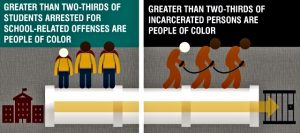“Robert was an 11-year-old in 5th grade who, in his rush to get to school on time, put on a dirty pair of pants from the laundry basket. He did not notice that his Boy Scout pocketknife was in one of the pockets until he got to school. He also did not notice that it fell out when he was running in gym class. When the teacher found it and asked whom it belonged to, Robert volunteered that it was his, only to find himself in police custody minutes later. He was arrested, suspended, and transferred to a disciplinary school.” 1
Stories like Robert’s are becoming commonplace. Kids are labeled as “criminals” or “problematic” before they are even teenagers. Zero tolerance policies are responsible for this criminalization of youth. These policies, initially created to combat drugs in the 1980s,2 were first implemented into schools in order to combat bullying.3 Now, these policies are used to punish a wide range of offenses in schools, some as juvenile as burping. Many scholars note that “Incidents once handled by a trip to the principal’s office are [now] dealt with by police and the justice system, contributing to the climate of suspension and exclusion.” 4. As such, increased use of zero-tolerance policies has led to an expansion of the school to prison pipeline.5 The term “school to prison pipeline” refers to the fact that a disproportionate number of low income and minority students are pushed out of school and into prison. As such, zero-tolerance policies have become tools that perpetuate institutional racism. They must be eliminated.

SEPARATE AND UNEQUAL: SCHOOL FUNDING IN ‘POST-RACIAL’ AMERICA. (n.d.). Retrieved May 10, 2017, from http://www.topmastersineducation.com/school-funding-post-racial-us/
This website explores how zero-tolerance policies are fueling the school-to-prison pipeline, who is responsible, who is helping, and what YOU can do to halt the mass incarceration of youths
